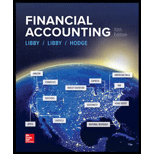
1)
Compute the given ratios for Year 3 of Incorporation CPK.
1)
Answer to Problem 9P
Compute the given ratios for Year 3 of Incorporation CPK.
| Ratio | Formula | Calculation | Result |
| Return on Equity (ROE) | (2.12)% | ||
| Net profit margin | (0.06)% | ||
| Inventory turnover | 92.81 times | ||
| Current ratio | 0.53 times | ||
| Quick ratio | 0.35 times | ||
| Debt-to-equity ratio | 7.02 times | ||
| Price/Earnings (P/E) ratio | (56.00) times |
Table (1)
Explanation of Solution
Return on equity ratio:
Return on equity of the Incorporation CPK is (2.12) %.
Profit margin:
Profit margin ratio is used to determine the percentage of net income that is being generated per dollar of revenue or sales.
Net profit margin of the Incorporation CPK is (0.06) %.
Inventory turnover ratio: Inventory turnover ratio is used to determine the number of times inventory used or sold during the particular accounting period.
Inventory turnover ratio of the Incorporation CPK is 92.81%.
Current ratio of the Incorporation CPK is 0.53 times.
Quick Ratio: It is a ratio used to determine a company’s ability to pay back its current liabilities by liquid assets that are current assets except inventory and prepaid expenses.
Quick ratio of the Incorporation CPK is 0.35 times.
Debt-equity ratio: The debt-to-equity ratio indicates that the company’s debt as a proportion of its stockholders’ equity.
Debt-to-Equity ratio of the Incorporation CPK is 7.02 times.
Price/Earnings Ratio: It depicts the relation of market price of a share to earnings per share of that company. The price/earnings ratio presents the market value of the amount invested to earn $1 by a company. It is major tool to be used by investors before the decisions related to investments in a company.
Price/Earnings ratio of the Incorporation CPK is (56.00) times.
2)
Identify that Whether the calculated inventory turnover for Incorporation CPK reasonable or not.
2)
Explanation of Solution
Incorporation CPK is engaging the restaurant business. Inventory turnover ratio of the Incorporation CPK is 92.81 which is very high. It is due to the nature of the business that is Incorporation CPK is in a business where purchasing inventory, processing and selling food to customers is on daily basis.
Hence, the inventory turnover ratio of the Incorporation CPK is reasonable.
Want to see more full solutions like this?
Chapter 13 Solutions
FINANCIAL ACCOUNTING (LOOSELEAF)
- I am trying to find the accurate solution to this general accounting problem with appropriate explanations.arrow_forwardAtlas Interiors sold office equipment costing $15,800 with accumulated depreciation of$12,400 for $2,600 cash. The entry to record the sale would include a gain or loss of what amount?arrow_forwardVortex Manufacturing is a start-up company that produces specialized computer chips. Vortex Manufacturing has budgeted four hours of direct labor per chip, at a standard cost of $22 per hour. During September, technicians actually worked 320 hours completing 85 chips. All 85 chips actually produced were sold. Vortex paid the technicians $21.50 per hour. What is Vortex's direct labor cost variance for September?arrow_forward
- Kraft's contribution margin is 35%. The company is contemplating an advertising campaign that will cost $18,450. If sales are expected to increase $72,800, by how much will the company's net income increase? Helparrow_forwardI am searching for the most suitable approach to this financial accounting problem with valid standards.arrow_forwardGeneral accounting questionarrow_forward
- Accurate answerarrow_forwardCompany C sets price equal to cost plus 45%. Recently, Company C charged a customer a price of $87 for an item. What was the cost of the item to Company C?arrow_forwardKraft's contribution margin is 35%. The company is contemplating an advertising campaign that will cost $18,450. If sales are expected to increase $72,800, by how much will the company's net income increase?arrow_forward

 AccountingAccountingISBN:9781337272094Author:WARREN, Carl S., Reeve, James M., Duchac, Jonathan E.Publisher:Cengage Learning,
AccountingAccountingISBN:9781337272094Author:WARREN, Carl S., Reeve, James M., Duchac, Jonathan E.Publisher:Cengage Learning, Accounting Information SystemsAccountingISBN:9781337619202Author:Hall, James A.Publisher:Cengage Learning,
Accounting Information SystemsAccountingISBN:9781337619202Author:Hall, James A.Publisher:Cengage Learning, Horngren's Cost Accounting: A Managerial Emphasis...AccountingISBN:9780134475585Author:Srikant M. Datar, Madhav V. RajanPublisher:PEARSON
Horngren's Cost Accounting: A Managerial Emphasis...AccountingISBN:9780134475585Author:Srikant M. Datar, Madhav V. RajanPublisher:PEARSON Intermediate AccountingAccountingISBN:9781259722660Author:J. David Spiceland, Mark W. Nelson, Wayne M ThomasPublisher:McGraw-Hill Education
Intermediate AccountingAccountingISBN:9781259722660Author:J. David Spiceland, Mark W. Nelson, Wayne M ThomasPublisher:McGraw-Hill Education Financial and Managerial AccountingAccountingISBN:9781259726705Author:John J Wild, Ken W. Shaw, Barbara Chiappetta Fundamental Accounting PrinciplesPublisher:McGraw-Hill Education
Financial and Managerial AccountingAccountingISBN:9781259726705Author:John J Wild, Ken W. Shaw, Barbara Chiappetta Fundamental Accounting PrinciplesPublisher:McGraw-Hill Education





